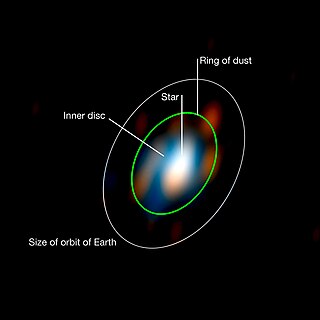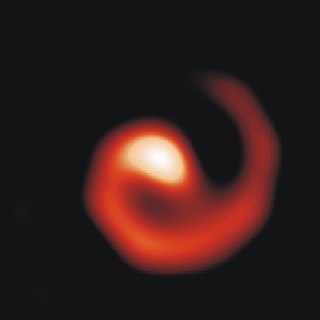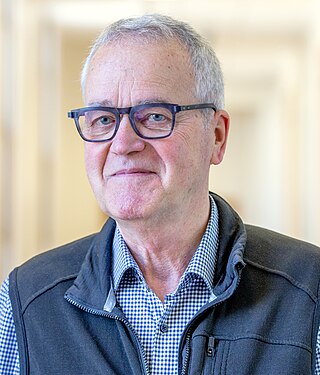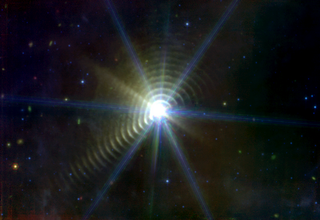Related Research Articles

The W. M. Keck Observatory is an astronomical observatory with two telescopes at an elevation of 4,145 meters (13,600 ft) near the summit of Mauna Kea in the U.S. state of Hawaii. Both telescopes have 10 m (33 ft) aperture primary mirrors, and, when completed in 1993 and 1996, they were the largest optical reflecting telescopes in the world. They are currently the third and fourth largest.

Wolf–Rayet stars, often abbreviated as WR stars, are a rare heterogeneous set of stars with unusual spectra showing prominent broad emission lines of ionised helium and highly ionised nitrogen or carbon. The spectra indicate very high surface enhancement of heavy elements, depletion of hydrogen, and strong stellar winds. The surface temperatures of known Wolf–Rayet stars range from 20,000 K to around 210,000 K, hotter than almost all other kinds of stars. They were previously called W-type stars referring to their spectral classification.

Speckle imaging comprises a range of high-resolution astronomical imaging techniques based on the analysis of large numbers of short exposures that freeze the variation of atmospheric turbulence. They can be divided into the shift-and-add method and the speckle interferometry methods. These techniques can dramatically increase the resolution of ground-based telescopes, but are limited to bright targets.
Aperture synthesis or synthesis imaging is a type of interferometry that mixes signals from a collection of telescopes to produce images having the same angular resolution as an instrument the size of the entire collection. At each separation and orientation, the lobe-pattern of the interferometer produces an output which is one component of the Fourier transform of the spatial distribution of the brightness of the observed object. The image of the source is produced from these measurements. Astronomical interferometers are commonly used for high-resolution optical, infrared, submillimetre and radio astronomy observations. For example, the Event Horizon Telescope project derived the first image of a black hole using aperture synthesis.

The Navy Precision Optical Interferometer (NPOI) is an American astronomical interferometer, with the world's largest baselines, operated by the Naval Observatory Flagstaff Station (NOFS) in collaboration with the Naval Research Laboratory (NRL) and Lowell Observatory. The NPOI primarily produces space imagery and astrometry, the latter a major component required for the safe position and navigation of all manner of vehicles for the DoD. The facility is located at Lowell's Anderson Mesa Station on Anderson Mesa about 25 kilometers (16 mi) southeast of Flagstaff, Arizona (US). Until November 2011, the facility was known as the Navy Prototype Optical Interferometer (NPOI). Subsequently, the instrument was temporarily renamed the Navy Optical Interferometer, and now permanently, the Kenneth J. Johnston Navy Precision Optical Interferometer (NPOI) – reflecting both the operational maturity of the facility, and paying tribute to its principal driver and retired founder, Kenneth J. Johnston.

Aperture masking interferometry is a form of speckle interferometry, that allows diffraction limited imaging from ground-based telescopes, and is a high contrast imaging mode on the James Webb Space Telescope. This technique allows ground-based telescopes to reach the maximum possible resolution, allowing ground-based telescopes with large diameters to produce far greater resolution than does the Hubble Space Telescope. The principal limitation of the technique is that it is applicable only to relatively bright astronomical objects. A mask is placed over the telescope which only allows light through a small number of holes. This array of holes acts as a miniature astronomical interferometer. The method was developed by John E. Baldwin and collaborators in the Cavendish Astrophysics Group.
A pinwheel nebula is a nebulous region in the shape of a pinwheel.

An astronomical interferometer or telescope array is a set of separate telescopes, mirror segments, or radio telescope antennas that work together as a single telescope to provide higher resolution images of astronomical objects such as stars, nebulas and galaxies by means of interferometry. The advantage of this technique is that it can theoretically produce images with the angular resolution of a huge telescope with an aperture equal to the separation, called baseline, between the component telescopes. The main drawback is that it does not collect as much light as the complete instrument's mirror. Thus it is mainly useful for fine resolution of more luminous astronomical objects, such as close binary stars. Another drawback is that the maximum angular size of a detectable emission source is limited by the minimum gap between detectors in the collector array.

WR 136 is a Wolf–Rayet star located in the constellation Cygnus. It is in the center of the Crescent Nebula. Its age is estimated to be around 4.7 million years and it is nearing the end of its life. Within a few hundred thousand years, it is expected to explode as a supernova.

WR 104 is a triple star system located about 2,580 parsecs (8,400 ly) from Earth. The primary star is a Wolf–Rayet star, which has a B0.5 main sequence star in close orbit and another more distant fainter companion.
In optical astronomy, interferometry is used to combine signals from two or more telescopes to obtain measurements with higher resolution than could be obtained with either telescopes individually. This technique is the basis for astronomical interferometer arrays, which can make measurements of very small astronomical objects if the telescopes are spread out over a wide area. If a large number of telescopes are used a picture can be produced which has resolution similar to a single telescope with the diameter of the combined spread of telescopes. These include radio telescope arrays such as VLA, VLBI, SMA, astronomical optical interferometer arrays such as COAST, NPOI and IOTA, resulting in the highest resolution optical images ever achieved in astronomy. The VLT Interferometer is expected to produce its first images using aperture synthesis soon, followed by other interferometers such as the CHARA array and the Magdalena Ridge Observatory Interferometer which may consist of up to 10 optical telescopes. If outrigger telescopes are built at the Keck Interferometer, it will also become capable of interferometric imaging.
The Mark III Stellar Interferometer was a long-baseline optical astronomical interferometer, located at the Mount Wilson Observatory, California, United States. It had a maximum baseline of 32 meters and operated in wavelengths between 450 and 800 nm. A joint venture between the United States Naval Observatory, the Naval Research Laboratory, the Smithsonian Astrophysical Observatory, and the Massachusetts Institute of Technology, it began operation in 1987 and was closed in 1992. The Naval Observatory later constructed a larger interferometer, the Navy Prototype Optical Interferometer.

The NASA Exoplanet Science Institute (NExScI) is part of the Infrared Processing and Analysis Center (IPAC) and is on the campus of the California Institute of Technology (Caltech) in Pasadena, CA. NExScI was formerly known as the Michelson Science Center and before that as the Interferometry Science Center. It was renamed NExScI in the Fall of 2008 to reflect NASA's growing interest in the search for planets outside of the Solar System, also known as exoplanets. The executive director of NExScI is Charles A. Beichman.

A colliding-wind binary is a binary star system in which the two members are massive stars that emit powerful, radiatively-driven stellar winds. The location where these two winds collide produces a strong shock front that can cause radio, X-ray and possibly synchrotron radiation emission. Wind compression in the bow shock region between the two stellar winds allows dust formation. When this dust streams away from the orbiting pair, it can form a pinwheel nebula of spiraling dust. Such pinwheels have been observed in the Quintuplet Cluster

Anthony (Tony) F.J. Moffat is an emeritus professor of astronomy at the Université de Montréal in Montreal, Quebec, Canada. He was appointed as a fellow of the Royal Society of Canada in 2001. Moffat's research focuses on massive stars, stellar winds, binary stars, as well as the structure and dynamics of star formation regions and galaxies.
WR 147 is a multiple star system in the constellation of Cygnus. The system is extremely reddened by interstellar extinction – that is, dust in front of the star scatters much of the blue light coming from WR 147, leaving the star appearing reddish.
The Sydney University Stellar Interferometer (SUSI) was an optical long baseline interferometer owned by The University of Sydney. It was located in the Paul Wild Observatory, 20 km west of Narrabri town in New South Wales, Australia. SUSI was initially proposed by Australian astronomer John Davis in 1985, who led the project through to completion in 1993 and past his retirement in 1996 until his death in 2010. From then until its closure in 2017 it was led by Peter Tuthill, and used as a test facility for instruments for the CHARA Array.

WR 140 is a visually moderately bright Wolf–Rayet star placed within the spectroscopic binary star, SBC9 1232, whose primary star is an evolved spectral class O4–5 star. It is located in the constellation of Cygnus, lying in the sky at the centre of the triangle formed by Deneb, γ Cygni and δ Cygni.

Apep is a triple star system containing a Wolf–Rayet binary and a hot supergiant, located in the constellation of Norma. Named after the serpent deity from Egyptian mythology, the star system is surrounded by a vast complex of stellar wind and cosmic dust thrown into space by the high rotation speed of the binary's primary star and formed into a "pinwheel" shape by the secondary star's influence. Ground-based studies of the system in the 2010s concluded that the system was the best-known gamma-ray burst progenitor candidate in the Milky Way galaxy.
References
- ↑ "University of Sydney faculty page". Archived from the original on 2023-02-20. Retrieved 2023-02-20.
- ↑ "40 trillion kilometres is a long way to look but this Sydney-designed custom telescope is up to the task". ABC News. 16 November 2021. Archived from the original on 2021-11-17. Retrieved 2023-02-20.
- ↑ "Prestigious Eureka science prizes awarded". ABC News. 9 August 2005. Archived from the original on 2023-02-20. Retrieved 2023-02-20.